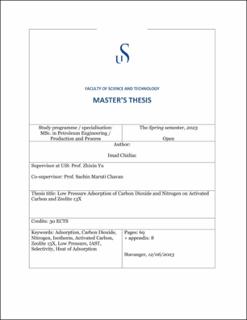| dc.description.abstract | Several gas separation techniques have been used throughout the year, however the most cost effective and energy efficient gas separation process to date is that of adsorption. Adsorption of carbon dioxide from flue or biogas streams is mostly done on activated carbons and zeolites.
In this study, carbon dioxide and nitrogen adsorption on activated carbon and Zeolite 13X samples were studied. The samples are consisted of three activated carbons synthesized by a battery company called Beyonder, in addition to a commercial activated carbon as well as a commercial zeolite 13X sample. The first part of the work is characterization of the samples using Scanning Electron Microscopy (SEM), Thermogravimetric analysis (TGA) and Nitrogen Physisorption for BET surface area and pore size distribution determination. Initial SEM data of the activated carbon samples has visually described size differences among the tested samples which were the cause of different activation intensities. In addition, the commercial activated carbon and zeolite 13X samples have shown more uniformity in their structure as compared to the non-commercial samples.
The carbon samples from Beyonder: SAC22-029, SAC21-037, and SAC21-050 were synthesized by the same base raw material and were shown to have surface areas of 931 m2/g, 2158 m2/g, and 2613 m2/g respectively according to increasing activation intensities where SAC21-050 was subjected to the highest among the samples. Also, the commercial activated carbon sample YEC8B and the commercial Zeolite 13X sample have surface areas of 1672 m2/g and 395 m2/g respectively. In addition to relating higher surface area of the carbon samples to their higher activation intensities, pore size distribution of those samples was calculated based on the Non-Local Density Function Theory (NLDFT). The pore size distribution of SAC22-029, SAC21-037, and SAC21-050 were compared which has shown that increasing activation intensities results in an increase in micropore volumes up to a certain extent after which the increase in activation intensity resulted in the collapse of micropores into larger mesopores.
Due to the heavy load on the adsorption instrument, the adsorption measurements was only done on the highest surface area carbon and the zeolite 13X sample in order to compare the carbon dioxide adsorption capacities of both samples. Adsorption of nitrogen and carbon dioxide was tested on both samples at three different temperatures and has shown SAC21-050 to have a higher adsorption capacity of nitrogen at all temperatures compared to zeolite. The activated carbon sample recorded a maximum capacity of 9 cm3/g at 283.15K as compared to zeolite having 6.5 cm3/g. In contrast, zeolite 13X has shown a significant superiority of adsorbing carbon dioxide when compared to the activated carbon sample. The zeolite sample shows a maximum capacity of 92 cm3/g at 283.15K as compared to that of activated carbon having a maximum of around 65 cm3/g. The difference in performance will be explained as being a cause of the surface chemistry differences between the two types of samples, their pore size distribution, their heat of adsorption, and their CO2/N2 selectivity.
The experimental data was fitted with the Langmuir and the Dual-Site Langmuir-Freundlich adsorption models where the latter has proven to be more accurate at representing the data. As a result, the DSLF model was chosen for further Ideal Adsorbed Solution Theory selectivity calculations due to the inclusion of the surface heterogeneity constant.
Zeolite 13X was determined to have a higher selectivity for carbon dioxide over nitrogen and a higher heat of adsorption making it more suitable for carbon dioxide separation. Taking into consideration some constraints of zeolite which includes its hydrophilic nature that will adhere its adsorption capability. | |
